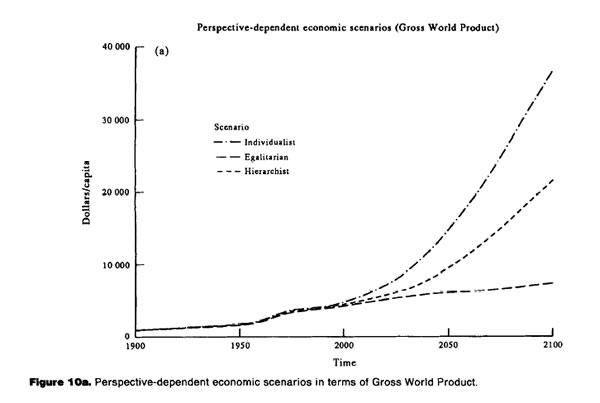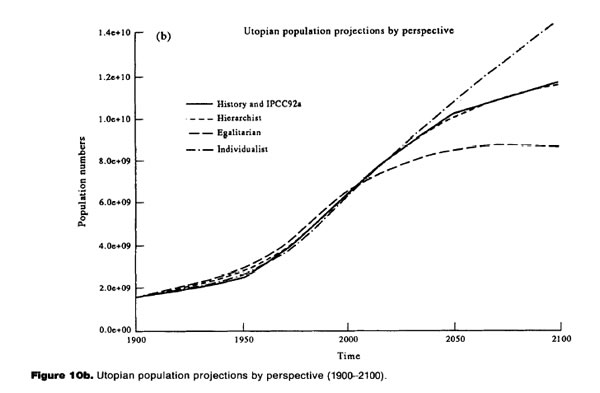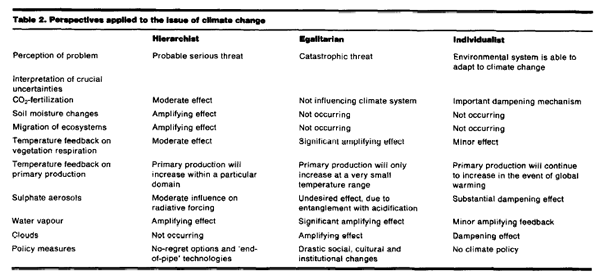Worldviews and Demographic Transition
pg 133 - Figure 6: Framework of perspectives
characteristic Hierarchist Egalitarian Individualist myth of nature tolerant within limits fragile robust myth of human sinful good and malleable self-seeking ethical attitude partnership ecocentrism anthropocentrism management style control prevention adaptation salient value stability equity and equality growth attitude towards risk risk-accepting risk-averse risk-seeking
pg 135 - "Will future population developments result in overpopulation either in environmental and/or socio-economic terms?"
pg 136 - three clusters of uncertainty for fertility dynamics: ethical, demographic and policy
"The demographic data do not allow us to derive an unambiguous understanding of the factors that trigger structural changes in fertility behaviour, ie the so-called "fertility transition".
pg 137 - "plausible and consistent hierarchist interpretation of the scientific uncertainties, namely: the myth of nature, the perception of human nature and the driving force."
nature is robust within limits vigorous population growth will end up in disaster as carrying capactity is exceeded physical limits to population humans follow governing institutions, such as state and church fertility decisions reflect state or church statements management style is to control family planning view, high birth rates are result of lack of availablity to contraception
pg 139 - egalitarian
life is fragile ecocentrism - humans just part of nature population growth violates qualtity of life for all tolerable population limit determined by social and ecological criteria generally preventative fertility choices modernization - "conditioned by social, educational, culturean and economic conditions they face, " policies improve conditions of women and children
pg 140 - individualistic
nature is an abundant resource that it takes skill to use fully people are resources - intellectual capital changes in fertility induced by socio-economic situations of individuals markets will provide contraception and other services if needed population policies laissez-faire to allow market mechanisms
pg 143 - "Utopias signify a situtation in which the population dynamics function according to the perspective's world view,... "
dynamic population models
population numbers 8.5 billion (stabilization - hierarchistc and egalitarian) to 14.2 (growth - individualistic)
UN projections all have a stabilization, but "our experiments suggest that the state-of-the-art knowlege does not allow for such a rigorous statement with regard to future developments"
Figure 10- different perspectives - poulation growth
set up equations for growth and then vary the parameters within different ranges for the different models
for example the impact of family planning may be more in one model than in the other
each perspective represents a extreme view - not a general population - use this extreme values "serves as a heuristic to estimate the bounds"
Fig 10a - growth or gross world product - <!-- note that the individualist and hierarchist don't level off -->

Figure 10b - the different population projections, the Hierachist matches the IPCC92a model

uncertainty on these estimates in 2100 the population in:
hierchist 2.5% of simulations had about 20 billion
egalitarian 2.5% of the simulations had about 10 billion
individualist --------------------------- 20 billion
pg 146 - The combination of these utopias with "classical uncertainty analysis" results in "images of the future which are probable in the light of state-of-the-art knowledge perceived from a variety of perspecties."
Risk assessment by comparing predictions from a perspective with different actual outcomes - i.e. dystopias
<!-- risk is associated with how well the management styles do when paired with the wrong world view -->
hierachistic strategy (which focuses on family planning)
with individualistic world view --> 15 billion people
with egal world view --> similar to hierachistic utopian matchbut not stable - continuous growth
family planning applied to indiv or egal world has less effect
stabilization of world pop below carrying capacity is "rather risky"
egal strategy (which focuses on education and legislation)
with indiv world view --> high fertility : risky strategy
with hierach world view --> dystopian situation is overshoot and collapse<!-- worst mismatch seems to be egalitarian strategy in a hierachical world because it results in overshoot and collapse-->
individualistic management (population is not considered a problem)
instead of continuous growth - results in stablization around 11 bil
this management is "not considered to be risky"
pg 150 - Robust strategies
"egalitarian governance in a hierachistic world and hiearchistic governance in an egalitarian world are problematic"
mixed policy - combination of education and family planning can lead to outcomes that are acceptable by both
